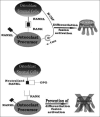The cell biology and role of resorptive cells in diseases: A review
- PMID: 28469115
- PMCID: PMC5452707
- DOI: 10.4103/aam.aam_97_16
The cell biology and role of resorptive cells in diseases: A review
Abstract
Resorptive cells are responsible for the resorption of mineralized matrix of hard tissues. Bone-resorbing cells are called osteoclasts; however, they can resorb mineralized dental tissues or calcified cartilage and then they are called odontoclasts and chondroclasts, respectively. Resorptive cells form when mononuclear precursors derived from a monocyte-macrophage cell lineage are attracted to certain mineralized surfaces and subsequently fuse and adhere onto them for exerting their resorbing activity. These cells are responsible for degradation of calcified extracellular matrix composed of organic molecules and hydroxyapatite. The activity of these cells can be observed in both physiological and pathological processes throughout life and their activity is mainly required in bone turnover and growth, spontaneous and induced (orthodontic) tooth movement, tooth eruption, and bone fracture healing, as well as in pathological conditions such as osteoporosis, osteoarthritis, and bone metastasis. In addition, they are responsible for daily control of calcium homeostasis. Clastic cells also resorb the primary teeth for shedding before the permanent teeth erupt into the oral cavity.
Resorptive cellules sont responsables de la résorption de la matrice minéralisée de tissus durs. Résorption osseuse cellules sont appelées ostéoclastes; cependant, ils peuvent résorber les tissus dentaires minéralisés ou de cartilage calcifié et puis ils sont appelés et odontoclasts chondroclasts, respectivement. Les cellules mononucléaires Resorptive formulaire lors de précurseurs dérivés d’une lignée de cellules monocytes-macrophages sont attirés par certaines surfaces minéralisées et ensuite le fusible et adhérer sur eux pour exercer leur activité de résorption. Ces cellules sont responsables de la dégradation de la matrice extracellulaire calcifiée composé de molécules organiques et de l’hydroxyapatite. L’activité de ces cellules peuvent être observés dans les deux processus physiologiques et pathologiques tout au long de la vie et leur activité est surtout nécessaire dans le renouvellement osseux et la croissance, spontanés et induits) orthodontie (mouvement des dents, l’éruption des dents, et la guérison de la fracture des os, ainsi que dans des conditions pathologiques telles que l’ostéoporose, l’arthrose, et des métastases osseuses. En outre, ils sont responsables de contrôle quotidien de l’homéostasie du calcium. Cellules clastiques résorbent également des dents d’avoir mis en avant les dents permanentes font éruption dans la cavité buccale.
Conflict of interest statement
There are no conflicts of interest.
Figures
References
-
- Cormack DH. Ham's Histology. 9th ed. Philadelphia: JB Lippincott Company; 1987.
-
- Lian JB, Stein GS, Canalis E, Robey PG, Boskey AL. Bone formation: Osteoblast lineage cells, growth factors, matrix proteins and the mineralization process. In: Favus MJ, editor. Primer on the Metabolic Bone Diseases and Disorders of Mineral Metabolism. Philadelphia: Lippincott Williams & Wilkins; 1999. pp. 14–29.
-
- Nakamura H. Morphology, function, and differentiation of bone cells. J Hard Tissue Biol. 2007;16:15–22.
-
- Väänänen HK, Zhao H, Mulari M, Halleen JM. The cell biology of osteoclast function. J Cell Sci. 2000;113(Pt 3):377–81. - PubMed
-
- Wang Z, McCauley LK. Osteoclasts and odontoclasts: Signaling pathways to development and disease. Oral Dis. 2011;17:129–42. - PubMed
Publication types
MeSH terms
LinkOut - more resources
Full Text Sources
Other Literature Sources






